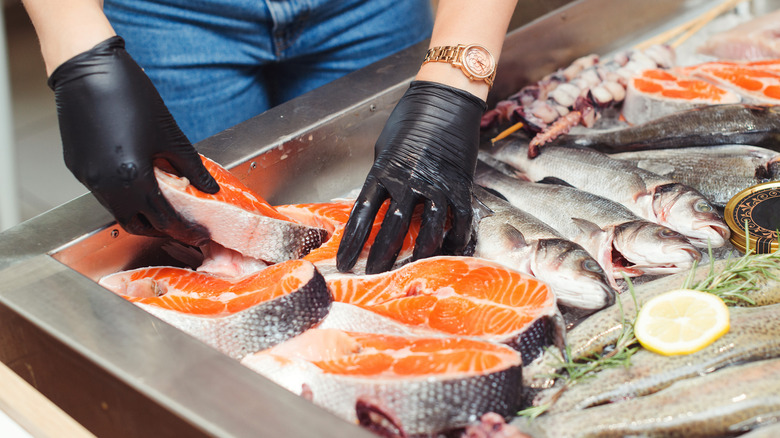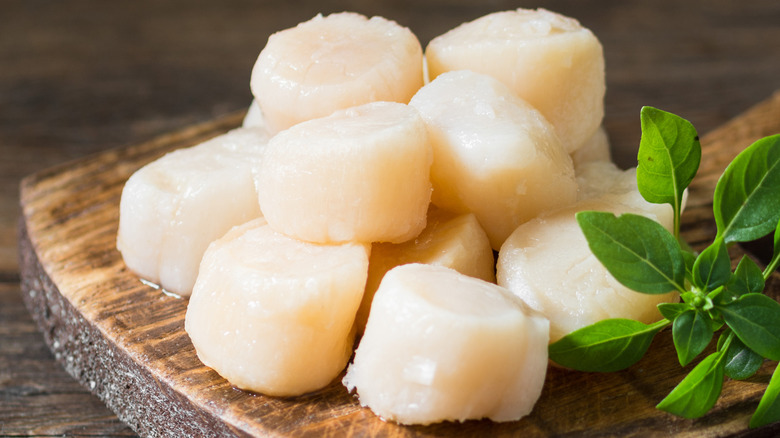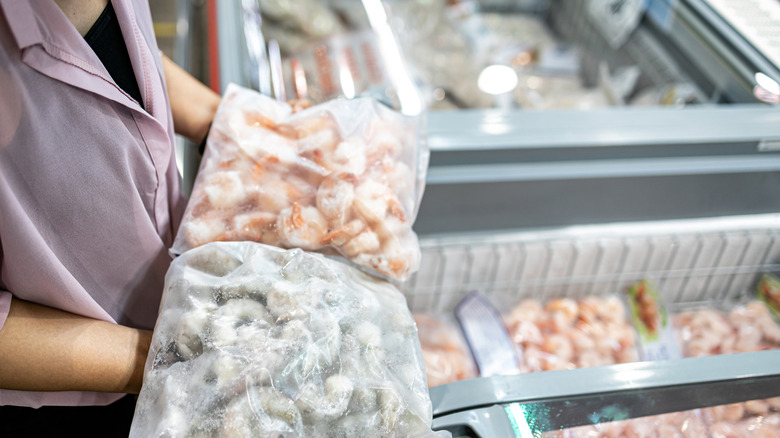The One Additive You Should Always Avoid When Buying Fish
Don't let a pearly white fish filet, a perfect reddish-orange piece of salmon, or an unblemished shrimp or scallop fool you into thinking they are totally fresh and unadulterated. They may in fact have been chemically treated to lull you into that false sense of security. According to Fish for Thought, typical characteristics of a healthy seafood specimen include natural coloration with a lack of discolored areas, firm flesh, and skin that is shiny, moist, and slippery to the touch. A fresh aroma is also essential.
However, some fish are exposed to additives to artificially add weight, improve appearance, tenderize the flesh, or disguise their subpar freshness, per The Healthy Fish. These chemicals only temporarily make the seafood seem larger, firmer, shinier, and healthier. The customer pays for this treatment at the cash register, and also ultimately sacrifices quality, texture, and flavor at the dining room table.
This substance also appears in detergents, paint, and dog food, even though it is classified by the U.S. Food and Drug Administration as "generally regarded as safe" when used in small quantities, explains ChefSteps. So what is this additive that we should be on the lookout for?
Sodium tripolyphosphate should be avoided
Sodium tripolyphosphate (STPP) is this oft-used chemical additive. Immersing seafood in slushy, STPP-infused brine increases the proteins' ability to hold water, thereby adding weight. The Splendid Table states it is meant to preserve quality while fish is stored and shipped, but the effect is illusory.
The doctored seafood may not cook properly, will shrink when heated, or easily fall apart. It might become soft, rubbery, or unpleasant tasting. Due to the artificially induced high water content, a telltale sign of STPP is shellfish that steams when sautéed rather than searing or caramelizing. Seafood treated with STPP is referred to as "wet," while untreated seafood is considered "dry." The outlet has a test to determine whether or not the scallops were treated. Place one in the microwave for a 15-second burst. If untainted, it will produce only a bit of water.
Hudson Valley Eats describes other differences between dry or wet scallops and shrimp. Pure-white scallops have most likely been treated, so it is best to purchase ones in their natural off-white or pink state. A firm springiness is typical of untreated shrimp, wet ones are softer and slimier. Ideally, the ingredients listed for frozen shrimp should include "shrimp" or "shrimp and water" only. Unfortunately, you are at the mercy of the fishmonger, counterperson, or server when inquiring about a product's purity.
Other additives to look for
Sodium tripolyphosphate is "considered safe in low doses by the Food and Drug Administration," (via The New York Times) but if you're looking for the best texture and flavor from your seafood, it's best to steer clear. Shrimp are typically dosed with the STPP additive after they are peeled, a good reason to purchase them with their shells still on. In the end, you may pay extra for healthy, untreated fish, but that is preferable to being gouged for seafood that has been treated with sodium tripolyphosphate.
And unfortunately, STPP is not the only fish additive you should be on the lookout for, per The Healthy Fish. Your portion of seafood might also contain traces of antibiotics, growth hormones, or carbon monoxide, which can be used to brighten the color. Other artificial coloring agents and a variety of preservatives are also sometimes added.
According to The Kitchn, some unscrupulous seafood processors use sodium bisulfates to disguise the harmless dark spots on shrimp shells or lobster tails caused by oxidation. Shrimps' normal black fin tips are also lightened with it. This is done purely for aesthetic reasons and might even mask seafood that is iffy. All the more reason to be especially picky when you approach the seafood counter.


